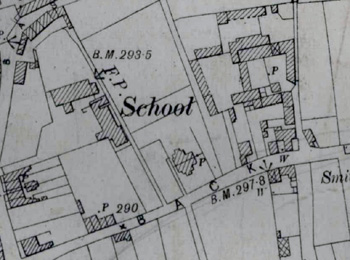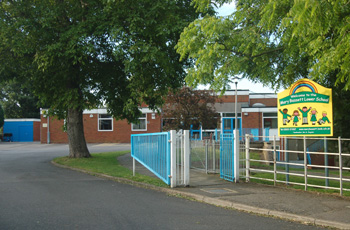Bassett Road Girls School Leighton Buzzard

Bassett Road schools in 1901
Directories state that the girls' school in Bassett Road was built in 1873. The school is also called Friday Street since, at that time, the road now called West Street was called Friday Street (as well as Back Lane!) and the site of the school was a corner plot on both West/Friday Street/Back Lane and Bassett Road. The return for Leighton Buzzard required under the Education Act 1870 laid out the rather bleak educational prospects for girls at the time. The return lists the Boys' British School, which had been founded in 1813, the British Infants' School in Bassett Road and the Pulford Church of England Boys' and Girls' Schools. Boys thus had twice the opportunity of girls to be educated further than the level of infants. At that date Saint Andrew's school was being built (for both boys and girls), even so it was felt that another school for girls would be needed and Bassett Road was the result. The problem for girls older than infants was that many were sent to so-called plait schools, where they were taught how to plait straw for sale to hat makers in Luton, and thus supplement the family income, but learned little else.
Bassett Road Girls' School, like the adjoining Infants' School was a British School, in other words it followed the form of education laid down by the British and Foreign Schools Society. A principal part of this was that education should be non-sectarian. In practice this meant that the British Schools tended to be supported by nonconformists since the alternative, unless there was a free or non-sectarian charity school in the parish, meant a National or Church of England School in which the Anglican catechism was taught.
The Education Act of 1902 abolished School Boards, replacing them with a Local Education Authority which, for Bedfordshire, was Bedfordshire County Council. Thus board schools became known as council schools. Bedfordshire & Luton Archives & Records Service has a scrapbook of cuttings of visits made to most Bedfordshire Schools by School Inspectors for a period from just before the First World War through the inter-war years [E/IN1/1].
The first inspection of this school in the volume came in 1910 when the inspector reported: "Considerable improvement has been effected since the last visit of inspection was paid. The weak points appear to have been carefully attended to, and with very satisfactory results. The lessons are now more thoroughly prepared by the young assistants and the teaching is more definite and effective, while the want of sympathy between teachers and taught, which was a marked feature in some of the classes in the past, has disappeared. Much of the work now is praiseworthy and order and tone are very good".
Two years later, average attendance 142, the inspector noted: "The condition of the School is quite satisfactory. Order is good, instruction is careful and suitable. The Assistants work well. The Head Mistress supervises with care and a generally creditable level of instruction is reached and maintained".
The next inspection was not until after the Great War, in 1919. Average attendance was now 156 and: "The work of this School deserves special commendation". Five years later, however, it was noted: When this School was inspected in September 1923, it was found that it had suffered somewhat seriously by reason of the lengthy absence, through illness, of the Head Teacher and two members of the staff. Vigorous efforts have been made to recover the lost ground, and these efforts have to a large extent been successful". Four year later, in 1928 it was noted: "The tone throughout the School is good. Other praiseworthy features are the Singing - the Department won the Challenge Shield for Sight Singing this yea, and the tone of the girls' voices was praised by the adjudicator - the Drawing and Handiwork of the older girls, the trouble taken in speech training, and the clean, clear writing and setting out of Arithmetic throughout". The work of one teacher was criticised as "ineffective".
The final report on the school came in 1931, when average attendance was 138. It was reported: "The work of this Department is very good in many respects and much of it is above average merit. It is carefully planned and supervised and the teachers' notes bear witness to the thoughtful preparation…The careful training the girls receive is seen in their manners and deportment, as well as in their speech".
On 1st April 1933 the school was reorganised as a Senior Girls School, for girls aged eleven to fourteen. The first report from the Senior Girls' School came in 1937, when average attendance was 148. "This School is well organised and has done, in its limited premises, consistently good work since its inception as a Senior School. There have been changes in the Staff in the past eighteen months; three good Teachers have left, and two whose work did not fit in well with the schemes were here for a short time only. The present staff are capable and work together in harmony. The most interesting feature, perhaps, is the success which has attended the introduction of Gardening. The School has been fortunate in that it received, and is receiving, most generous gifts of excellent shrubs and plants from the famous Grower whose gardens and houses are situated in the village near by; and in that it has Mistresses well qualified in the subject. The girls are most enthusiastic in this side of their work, which the Authority is fostering and encouraging. Needlework is also a strong feature; Folk and Scottish dances are enjoyed; and the ordinary work is directed well by the Head Mistress, whose influence is admirable. She deserves every recognition for her devotion to the best interests of the school, and for the backing she obtains so readily from the staff".
This school continued until 1946 when the Education Act 1944 came into force and the school was reorganised as Mary Bassett County Secondary Modern School for girls, named after the daughter of the founder of Bassett Road Infants' School in 1839, John Bassett. Secondary Moderns were designed for the 75% of pupils who did not achieve top marks in the Eleven Plus examination, the top 25% going to a Grammar School which, in Leighton Buzzard, meant Cedars School. A Secondary Modern taught a more skills based curriculum, intended to fit pupils for a life of work whereas in the Grammar School emphasis was placed on more academic subjects with a view to pupils going on to attend university. In January 1959 the school merged with the equivalent school for boys in the town in Beaudesert and the merged school met in new purpose built premises in Brooklands Drive and was known as Brooklands County Secondary Modern School. The old school buildings were then demolished and the current Mary Bassett Lower School built on the site.

Mary Bassett Lower School June 2008
Sources
- SB26/2: conveyance of land by Sell and others to the School Board: 1894;
- SB26/3: abstract of title of Basset's Trustees: 1900;
- SB26/4: agreement for sale by Basset's Trustees to the School Board: 1900;
- SB26/5: conveyance of school to the School Board: 1900;
- E/IN1/1: inspector's reports: 1910-1931;
- E/IN1/1: inspector's report: 1937